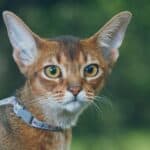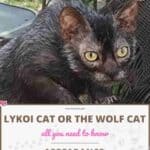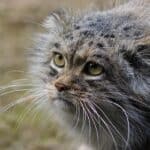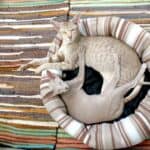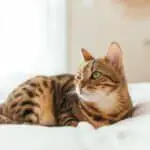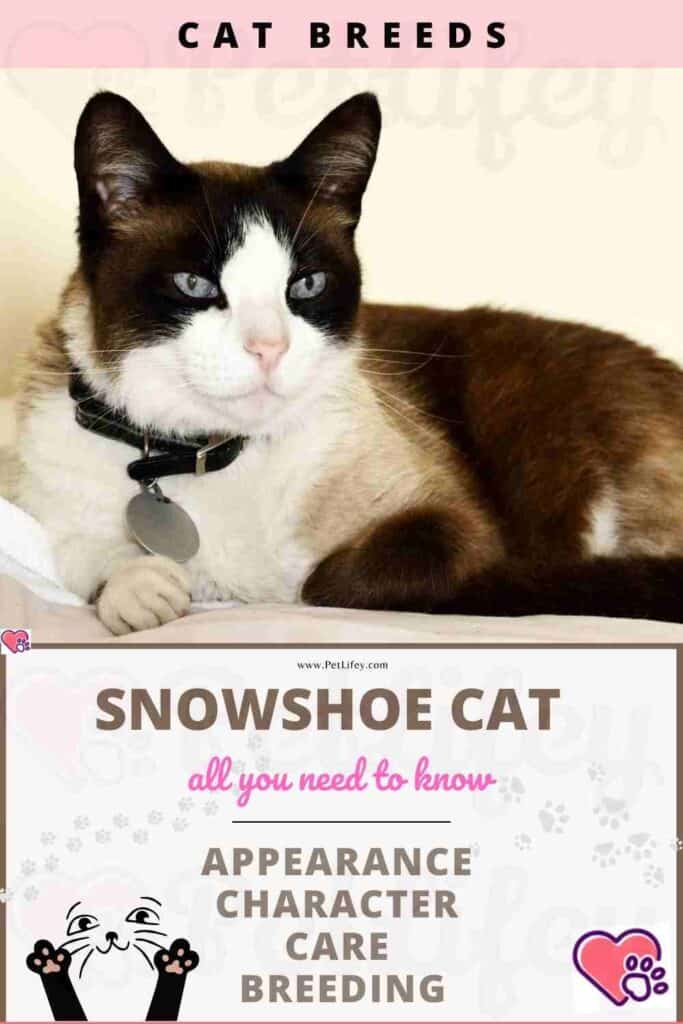
Born in America, the Snowshoe cat(which means “snow shoes”) owes its name to its feet covered with a very beautiful white hair contrasting sharply with the ends of the legs which darken slightly at the point of junction with these boots.
Although very successful, it is not a very widespread cat because for breeders it is not easy to obtain perfect kittens that meet all the requirements for color and the correct distribution of white.
As it counts the Siamese among its ancestors, it inherited its irrepressible desire to always be the centre of attention and a frankly above normal curiosity; it is a perfect companion cat, but you have to resign yourself to finding it stuffed in the most unthinkable places.
The origins of the Snowshoe Cat
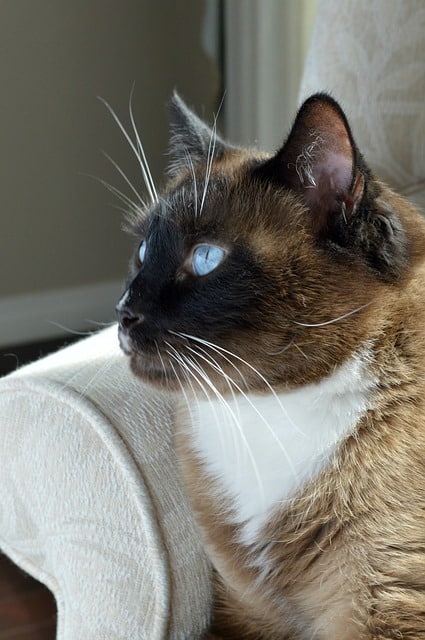
In the late 1970s, a Philadelphia breeder, Dorothy Hinds-Daugherty, found in the middle of a Siamese litter a kitten that exhibited the color characteristics of the Snowshoe cat and, appreciating them very much, she tried to obtain a new breed of cats similar to this one; for this, she crossed Siamese with two-colored American Shorthairs.
Obtaining the desired result by crossing these two breeds is very difficult: in the first generation, we do not immediately obtain Siamese-colored kittens, because the gene which comprises it is recessive, whereas there may be some. have a few bicolors, or all, or none at all. This means that to get a Snowshoe it takes several generations.
After a few years, Vikki Olander, in Virginia, continued the work that Mrs. Hinds-Daugherty had given up; she sketched the first standard and finally, in 1983, the Snowshoe was admitted among the breeds recognized in the CFA (Cat Fanciers’ Association) championship.
Then, the other prestigious associations accepted it gradually, until its official recognition.
Appearance of the Snowshoe Cat
Its size can be medium or large, the structure, well balanced, is massive, strong and muscular; overall, it looks powerful but nimble.
The medium sized head is proportionate to the body, as long as it is wide and slightly rounded; the cheekbones are high, the cheeks well developed, especially in males; the profile is almost straight and the nose of medium length.
The ears are medium in size, placed on the sides of the head to continue the line of the cheeks; they are rounded at the tips and rather broad at the base.
The eyes are large, wide open and wide apart; they have the shape of a hazelnut, are neither round nor oblique; their color is always intense blue.
The body is rectangular: the legs are moderately long and proportionate to the body, they have a strong bone structure, a well-developed musculature and end in oval and compact feet.
The tail, at least as long as the body, is thicker at the base and tapers slightly towards the tip. The dress is short and provided.
Coat color of the Snowshoe Cat
Body color tones should be clear, ivory if possible, with sharp tips – i.e. ears, tail, legs and muzzle – contrasting in seal (brown) or blue.
The feet will always be white, as will the symmetrical break on the muzzle in the shape of an inverted “V” which extends over the throat, chest and stomach. The white breaks must always be as clear and as symmetrical as possible.
The character of the Snowshoe Cat
A very educated cat, it always seems to ask its owner’s permission before doing anything; we find in it the talkative side of the Siamese, although in a mitigated way, as well as all its curiosity and its liveliness.
Intelligent, kind and very friendly, the Snowshoe cat is really affectionate, a real cuddler; However, this does not prevent them from being also very playful and sometimes rather a joker.
Rather exclusive in its friendships, it is also a bit self-centered and, for them, being the center of attention is a real necessity.
Hug:
Usually considered sociable, gentle, and cuddly.
Player:
Daily play sessions are a great way to keep them active and to meet their need for exercise.
Calm:
It has a reputation for being both calm and lively, pleasantly balancing play sessions and periods of rest.
Intelligent:
Inquisitive and perceptive, the Snowshoe enjoys exploring its living environment to discover clever solutions to its constraints and achieve its ends. It is an excellent candidate for training aimed at learning selected behaviours, such as sitting on demand or giving a paw.
Fearful / suspicious of strangers:
Usually shows a great interest in new things. Of course, there are many factors that can influence cats’ distrust of strangers, including their life history.
Independent:
This cat can acclimate to a rather solitary life if its needs for stimulation and physical activities are met. However, note that many individuals demonstrate great sociability.
Behavior of the Snowshoe Cat
Talkative:
Many cats of this breed are quick to vocalize. They are talkative and willing to have conversations with members of their family.
Greedy / glutton:
Rather active, this cat can develop a tendency to gluttony. Feeding them in interactive bowls can satisfy its need for stimulation and manage its appetite.
Need for exercise:
It has a great need for exercise which can be met by playing alone or in a team with its family.
Runaway:
Eager for discovery, this feline would have the reputation of being an explorer cat. We must therefore be vigilant.
Compatibility of the Snowshoe Cat with other animals
The Snowshoe and the Dogs:
This cat can acclimatize to life with a dog, especially because it seeks social interactions.
However, it is necessary to plan for a gradual introduction as well as an environment comprising heights, where the cat can take refuge to escape unwanted interactions.
The Snowshoe and Other Cats:
Appropriate socialization in the kitten, a gradual introduction of one cat to another and an environment rich in heights are all factors that facilitate cohabitation between the cats in the household.
The Snowshoe and Children:
It is important to take the time to properly explain the cat’s body language to children. To build a mutually beneficial relationship, children must learn to respect their feline’s limits. Hours of shared play, cuddles and fun follow.
The Snowshoe and the Elderly:
It goes without saying that a lot of variation in behaviour is seen in cats, even in individuals of the same breed. Since the Snowshoe is both calm and active, it could be a good companion for a rather calm person. The latter must obviously be able to assume its responsibilities throughout the life of her cat.
Price of the Snowshoe Cat
On average, it costs between 750 USD and 1600 USD for the purchase of a Snowshoe kitten in breeding. The price usually varies depending on the rarity, lineage, breeding, age and sex. For the monthly budget, a minimum of 50 USD / month is necessary to meet the food and medical needs of his cat, while making sure to keep them in good health.
Maintenance of the Snowshoe Cat
Grooming:
Grooming is very easy and usually just involves brushing every now and then.
Hair
loss : Hair loss is not very pronounced.
Food for the Snowshoe Cat
A quality diet appropriate to its age and medical requirements is necessary. It is necessary to provide adequate food to meet its energy needs, considering that it is active and playful.
Health of the Snowshoe Cat
Life expectancy:
The average longevity is 12 to 15 years , but some live much longer.
Resistant / Robust:
Short, dense fur gives it some protection against the cold, although it remains limited. It is therefore not considered particularly resistant to extreme temperatures.
Tendency to gain weight:
There are several risk factors for feline obesity, such as the cat’s age, environment, diet and activity. This breed does not have a particular predisposition to being overweight, being rather energetic. The risk of developing overweight is greatly reduced when the need for physical activity is met.
Common Illnesses:
Since the Snowshoe is rare, data on the health of individuals is scarce. Although it is generally recognized that cats of this breed have good physiological health, an annual medical check-up is recommended. Some individuals can suffer from the same diseases as other domestic cats, such as oral diseases.
Reproduction:
Despite the relative rarity of the breed, only marriages with the Snowshoe are allowed.
Good to know
The famous Grumpy Cat that has caused a sensation on the internet in recent years could possibly have Snowshoe ancestors. This cat is said to be suffering from feline dwarfism.


